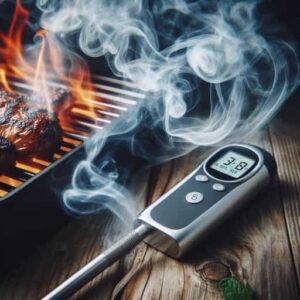Nailing the perfect BBQ requires precision, and a meat thermometer is your trusty sidekick in this culinary quest. Safety comes first! A meat thermometer ensures that you’re hitting the right internal temps to avoid any foodborne nasties. Whether it’s chicken, beef, or pork, different meats have specific safe temperatures, and guessing just isn’t worth the risk.
Next, let’s talk about getting that perfect doneness. No one likes an overcooked steak or undercooked chicken, right? Using a meat thermometer means you can kiss those worries goodbye. You’ll hit that sweet spot every single time, ensuring juicy, flavoruful results that’ll have folks coming back for seconds. The Best Meat Thermometers For Perfectly Cooked BBQ
Consistency is king in the BBQ world. Cooking for a crowd? No problem. A meat thermometer gives you repeatable results, so whether it’s your first burger or the tenth steak, each one gets its moment of perfection. It’s the secret weapon for those looking to up their BBQ game and wow their guests with every bite.
For novices and seasoned grill-masters alike, a meat thermometer offers peace of mind. Newbies can cook with confidence, knowing they’re getting it right. Pros can fine-tune their craft, exploring various techniques and recipes without the anxiety of over- or undercooking. It’s all about enjoying the BBQ experience and sharing excellent food.
Types of Meat Thermometers: Choosing the Right Tool for the Job
Choosing the right meat thermometer can feel like walking into a candy store – so many options, and each has its perks. Let’s break it down.
Instant-read thermometers are the quick-draw artists of the BBQ world. Stick them into your meat for a few seconds, and boom – you’ve got your readout. Perfect for those moments when you need an accurate temp in a hurry.
Leave-in thermometers are your slow-and-steady sidekicks. They stay in the meat throughout the cooking process. With probes attached to digital monitors, you can keep an eye on the temperature without lifting the lid, making them ideal for those marathon smoking sessions.
Digital thermometers are like the tech-savvy cousins of the analog ones. They give precise digital readings and often come with extra features like timers and alarms to add a layer of convenience. Analog ones might lack in the bells-and-whistles department, but they’re sturdy and do the job just fine if you’re going old-school.
Probe thermometers are a BBQ enthusiast’s dream. They come with multiple probes, ideal when you’re cooking different types of meat simultaneously. These let you monitor several pieces at different temps, ensuring everything gets cooked just right – no more chicken getting dry while the ribs are still cooking.
When choosing a meat thermometer, look for key features such as durability, ease of use, and readability. Waterproof designs can save the day if you tend to get splashy. Backlit screens are awesome for those late-evening grilling sessions. And don’t forget the range for wireless models; knowing your temps without being glued to the grill is a game-changer.

Differences Between Meat Thermometers and Cooking Thermometers
Understanding the difference between meat thermometers and cooking thermometers can clear up a lot of confusion and make your cooking life easier. Both tools play unique roles in the kitchen, but knowing when and how to use each can elevate your culinary game.
Let’s start with design and purpose. Meat thermometers, as the name implies, are specifically designed to measure the internal temperature of meats. They’re built tougher to withstand the heat of a BBQ or grill, and they focus on higher temperature ranges. In contrast, cooking thermometers cover a wider array of tasks beyond meat. Think candy-making or checking the temp of oil while frying. They’re versatile but might not handle the high-heat BBQ scene as well.
When it comes to temperature ranges, meat thermometers zero in on the crucial temps for various meats – typically from around 120°F to 200°F (49°C to 93°C). Cooking thermometers often have a broader range, making them suitable for a variety of dishes. Accuracy is key for both, but a meat thermometer’s precision is usually honed for those meat-safe temperatures.
Using them right is another piece of the puzzle. Meat thermometers are your go-to for roasts, steaks, burgers, and grilled chicken. Cooking thermometers shine in recipes that require precise temperature control, like syrups, sauces, and deep frying.
Common misconceptions often lead to misuse. Some people think one thermometer can do it all, but that’s not quite true. Using a meat thermometer in boiling sugar might not yield the best results, just like using a candy thermometer for your brisket probably won’t give you the accuracy you need. Knowing the strengths of each type helps you choose wisely for the best culinary outcomes.
Using and Maintaining Your Meat Thermometer for the Best BBQ Experience
Placement is everything when using a meat thermometer. Insert the probe into the thickest part of the meat, avoiding bones and fat for the most accurate reading. With poultry, aim for the inner thigh or breast. For steaks and chops, go for the center to gauge the perfect doneness.
Timing is another crucial element. For instant-read thermometers, check the temperature at the end of cooking for those quick checks. Leave-in thermometers are a set-and-forget type deal; just keep an eye on the monitor or app for updates. This way, you get real-time progress without constantly opening the grill and losing heat.
A common question: Can you leave a meat thermometer in the BBQ? For leave-in models, absolutely. They’re designed to withstand prolonged exposure to heat. Don’t use instant-read thermometers the same way; they’re for those quick checks only. Always double-check the manufacturer’s guidelines to be sure.
Proper cleaning and maintenance extend the life of your meat thermometer. After each use, wipe down the probe with hot, soapy water and dry it thoroughly. For digital thermometers, avoid submerging the electronic parts. A bit of care goes a long way in preserving the accuracy and functionality of your thermometer.
Troubleshooting is part of the BBQ journey. If your readings seem off, consider recalibrating your thermometer according to the manual’s instructions. Some digital models allow for easy recalibration at home. If the problem persists, it might be time for a replacement. Regularly checking the accuracy ensures perfectly cooked meat every time.
Using a meat thermometer takes a lot of guesswork out of BBQ, letting you focus on flavour and technique. You’ll not only ensure food safety but also consistently deliver delicious results that make every BBQ a hit.
**This post contains affiliate links. If you make a purchase through these links, I may earn a commission at no extra cost to you.**
Check out this highly rated meat thermometer to use with your mobile phone and an app – https://amzn.to/4552qVX

